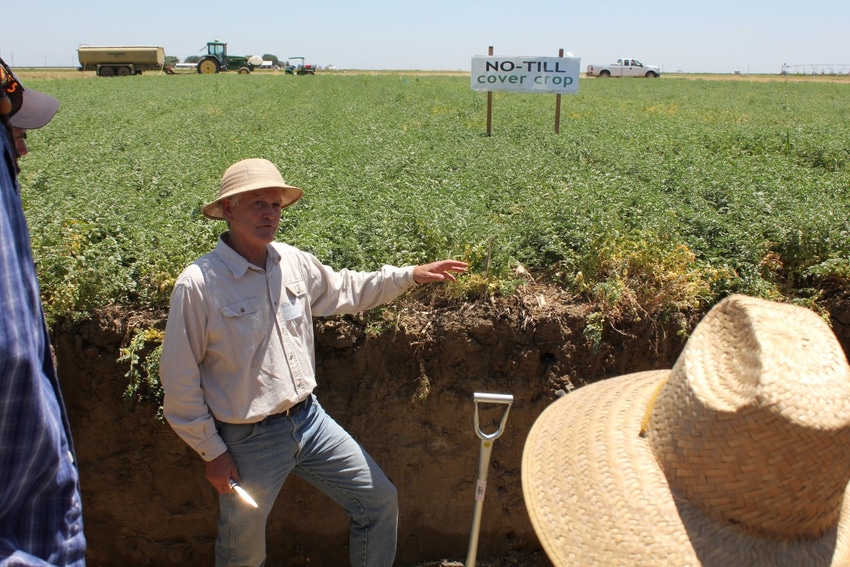June 20, 2017

It seems in recent years it has become all the rage to make sure that the dirt under our feet – and plants or trees - is healthy in order to sustain farming.
Soil health was the chief topic at a University of California soil health field day held at Five Points, attended by about 200 people including boots-on-the-ground farmers and researchers.
Jeff Mitchell, University of California (UC) Cooperative Extension cropping systems specialist at Fresno County, has been toiling in the trenches - literally - for some 20 years, seeking to illustrate the value of cover crops, and no or low-till agriculture.
At the workshop held at the UC West Side Field Station, Mitchell had trenches to showcase, pits that showed differences between conventional and no-till farming. Speakers on hand discussed some of those differences.
Improved soil health
Mitchell, the growers, and others emphasized that managing for better soil health was best achieved by minimizing soil disturbance, maximizing the diversity of plants in rotation or used as cover crops, keeping living roots in the soil as much as possible, and keeping the soil covered with plants and plant residue at all times.
“I have something growing in the ground 365 days a year,” said Scott Park with Park Farming in Meridian in the Sacramento Valley. “Having roots in the ground is 10,000 times better than adding biomass.”
Making money while saving the Earth
Park, a highly diversified farmer, says he moved to a no-till, cover crop approach about 30 years ago after realizing that his tillage efforts were costly. He subsequently became “sensitive to the soil” and adapted no-till and cover crops, not because he was driven to be environmentally sensitive but because his newfound way of farming “was making me a lot of money.”
“If it’s saving the Earth so much the better,” Park said.
His approach means using few if any nutritional inputs, he said, and he uses less water. Moreover, he shared that his insect pest problems - notably from leafhoppers in processing tomatoes - are significantly lower.
Just as Mitchell stresses that there is a learning curve to making the switch to no-till and cover crops, Park has learned he needs to “be thoughtful” in cover crop selection. “Cereals don’t break down easily,” he said.
Jesse Sanchez with Sano Farms in Firebaugh said, “Soil health is the way to go, but it takes time to learn. Cover crops benefitted our operation 100 percent.”
Four soil health approaches
Mitchell said much has been learned from a research plot at the UC center where four approaches take place, including standard tillage and no cover crop, standard tillage and cover crops, no tillage and no cover crop, and no tillage and cover crops.
“Behind me is a very important field,” he said, referring to a research plot home to a growing number of crops in recent years, including cotton, processing tomatoes, corn, wheat, garbanzo beans, and sorghum.
Mitchell closed the meeting with the observation he believes it’s possible to grow still more crops using the no-till/cover crop approach which has gained more favor in the wake of years of drought. For one thing, he said the system of adding residue keeps the ground cooler which keeps soil organisms alive and saves water use.
Sloane Rice, a hydrology student at UC Davis, echoed the notion that cover crops are a key to improving water management by increasing water retention.
Other savings from no-till have long been known, including reduced labor costs, wear and tear on tractors, and savings on diesel fuel due to fewer passes across field. In addition, dust is reduced by nearly 70 percent.
Armchair scientist
Retired organic grower Tom Willey conceded there have been some challenges to those who grow organically. Willey said he struggled for 30 years to get more attention from scientists and researchers on organic production.
“I had to become an armchair scientist,” Willey noted.
He added that organic farmers “till and cultivate more intensively than their conventional brethren.”
“Until organic systems somehow learn to embrace no-till, a unique challenge in vegetable production, we’ll need to shovel lots of ‘coal’ into the firebox, possibly outstripping compost feedstock resources should acreage greatly expand,” Willey said.
He said soil-applied compost functions “like an interest-bearing savings account.” Nitrogen slowly mineralizes through secondary microbial degradation of organic matter, and nutrients are released from “predator-prey” soil interactions.
Willey said a better understanding of soil biology “is poised to take almost all of the chemicals out of agriculture. It will bring good farming and we won’t have to call it conventional or organic - just good farming.”
The new emphasis on good farming has truly moved into the soil, not just looking at yields and production of what is growing above it. It means looking at the complex interaction of microbial organisms underground and takes into carbon added to the soil.
Healthy soil = genetic diversity
Howard Ferris, UC, Davis nematologist, looked at the suppression of pest species underground, pointing out that some nematodes are beneficial in keeping problem nematode pests at bay.
He said healthy soil sustains plant and animal productivity, and provides a reservoir for genetic diversity. Organisms in the soil decompose organic materials, sequester and redistribute minerals, mineralize organic compounds, and regulate and suppress pests.
They improve soil structure and reduce soil erosion.
“With healthy soil, you can smell it,” Ferris said. “It’s healthy and alive.”
With the diversity of species in the soil comes higher levels of carbon, he said.
Radomir Schmidt, UC Davis soil microbiologist, referred to soil as part of “a solar-powered engine.” He is researching DNA sequencing of microbes, a complex process that could help in better understanding interactions of various microbes.
You May Also Like




